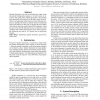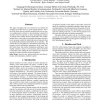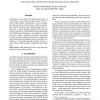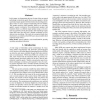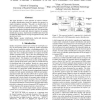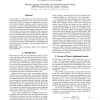INTERSPEECH
2010
13 years 7 months ago
2010
Speaker diarization is the task of partitioning an input stream into speaker homogeneous regions, or in other words, to determine "who spoke when." While approaches to t...
INTERSPEECH
2010
13 years 7 months ago
2010
This paper examines the lexical entrainment of real users in the Let's Go spoken dialog system. First it presents a study of the presence of entrainment in a year of human-tr...
INTERSPEECH
2010
13 years 7 months ago
2010
This paper investigates the use of speech-to-text methods for assigning an emotion class to a given speech utterance. Previous work shows that an emotion extracted from text can c...
INTERSPEECH
2010
13 years 7 months ago
2010
We present a novel scheme for indexing "hot spots" in conversations, such as poster sessions, based on the reaction of the audience. Specifically, we focus on laughters ...
INTERSPEECH
2010
13 years 7 months ago
2010
INTERSPEECH
2010
13 years 7 months ago
2010
In this paper, we demonstrate the use of state-of-the-art speech technology to transform speech from a source speaker to mimic a particular target speaker with the intention of pr...
INTERSPEECH
2010
13 years 7 months ago
2010
Recently, Deep Belief Networks (DBNs) have been proposed for phone recognition and were found to achieve highly competitive performance. In the original DBNs, only framelevel info...
INTERSPEECH
2010
13 years 7 months ago
2010
This paper describes a novel approach to improve monoaural speaker identification where two speakers are present in a single-microphone recording. The goal is to identify both of ...
INTERSPEECH
2010
13 years 7 months ago
2010
In a previous paper we proposed Web-based language models relying on the possibility theory. These models explicitly represent the possibility of word sequences. In this paper we ...
INTERSPEECH
2010
13 years 7 months ago
2010
